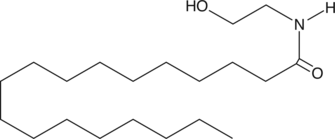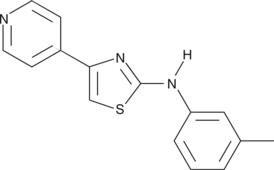Chemicals
Showing 36601–36750 of 41137 results
-
Stearic acid-d4 is intended for use as an internal standard for the quantification of stearic acid (Item No. 10011298) by GC- or LC-MS. Stearic acid is a long-chain saturated fatty acid. It is a major component of cocoa butter and has also been found in beef fat and vegetable oils.{48415,48416,48417} Unlike many long-chain saturated fatty acids, dietary stearic acid does not induce hypercholesterolemia or raise LDL-cholesterol.{48418}
Brand:CaymanSKU:30549 - 100 mgAvailable on backorder
Stearic acid-d4 is intended for use as an internal standard for the quantification of stearic acid (Item No. 10011298) by GC- or LC-MS. Stearic acid is a long-chain saturated fatty acid. It is a major component of cocoa butter and has also been found in beef fat and vegetable oils.{48415,48416,48417} Unlike many long-chain saturated fatty acids, dietary stearic acid does not induce hypercholesterolemia or raise LDL-cholesterol.{48418}
Brand:CaymanSKU:30549 - 250 mgAvailable on backorder
Stearic acid-d4 is intended for use as an internal standard for the quantification of stearic acid (Item No. 10011298) by GC- or LC-MS. Stearic acid is a long-chain saturated fatty acid. It is a major component of cocoa butter and has also been found in beef fat and vegetable oils.{48415,48416,48417} Unlike many long-chain saturated fatty acids, dietary stearic acid does not induce hypercholesterolemia or raise LDL-cholesterol.{48418}
Brand:CaymanSKU:30549 - 50 mgAvailable on backorder
Stearidonic acid is an 18-carbon, ω-3 fatty acid which is a dietary precursor to EPA and DHA. Stearidonic acid is present in small amounts in seed oils, especially black currant seed oil.
Brand:CaymanSKU:90320 - 1 mgAvailable on backorder
Stearidonic acid is an 18-carbon, ω-3 fatty acid which is a dietary precursor to EPA and DHA. Stearidonic acid is present in small amounts in seed oils, especially black currant seed oil.
Brand:CaymanSKU:90320 - 10 mgAvailable on backorder
Stearidonic acid is an 18-carbon, ω-3 fatty acid which is a dietary precursor to EPA and DHA. Stearidonic acid is present in small amounts in seed oils, especially black currant seed oil.
Brand:CaymanSKU:90320 - 25 mgAvailable on backorder
Stearidonic acid is an 18-carbon, ω-3 fatty acid which is a dietary precursor to EPA and DHA. Stearidonic acid is present in small amounts in seed oils, especially black currant seed oil.
Brand:CaymanSKU:90320 - 5 mgAvailable on backorder
Stearidonic acid (18:4ω-3) is a rare polyunsaturated fatty acid of the ω-3 series. In normal humans, it represents less than 0.25% of serum phospholipid fatty acids.{8460} It is present in certain natural oils such as echium and black currant seed, and to the extent that these oils are incorporated into nutraceuticals, stearidonic acid can become a significant polyunsaturate in the human diet. Stearidonic acid ethyl ester is an ester version of the free acid that is less water soluble, but more amenable for the formulation of stearidonate-containing diets and dietary supplements.
Brand:CaymanSKU:10006856 - 1 mgAvailable on backorder
Stearidonic acid (18:4ω-3) is a rare polyunsaturated fatty acid of the ω-3 series. In normal humans, it represents less than 0.25% of serum phospholipid fatty acids.{8460} It is present in certain natural oils such as echium and black currant seed, and to the extent that these oils are incorporated into nutraceuticals, stearidonic acid can become a significant polyunsaturate in the human diet. Stearidonic acid ethyl ester is an ester version of the free acid that is less water soluble, but more amenable for the formulation of stearidonate-containing diets and dietary supplements.
Brand:CaymanSKU:10006856 - 10 mgAvailable on backorder
Stearidonic acid (18:4ω-3) is a rare polyunsaturated fatty acid of the ω-3 series. In normal humans, it represents less than 0.25% of serum phospholipid fatty acids.{8460} It is present in certain natural oils such as echium and black currant seed, and to the extent that these oils are incorporated into nutraceuticals, stearidonic acid can become a significant polyunsaturate in the human diet. Stearidonic acid ethyl ester is an ester version of the free acid that is less water soluble, but more amenable for the formulation of stearidonate-containing diets and dietary supplements.
Brand:CaymanSKU:10006856 - 5 mgAvailable on backorder
Stearidonic acid (18:4ω-3) is a rare polyunsaturated fatty acid of the ω-3 series. In normal humans, it represents less than 0.25% of serum phospholipid fatty acids.{8460} It is present in certain natural oils such as echium and black currant seed, and to the extent that these oils are incorporated into nutraceuticals, stearidonic acid can become a significant polyunsaturate in the human diet. Stearidonic acid ethyl ester is an ester version of the free acid that is less water soluble, but more amenable for the formulation of stearidonate-containing diets and dietary supplements.
Brand:CaymanSKU:10006856 - 500 µgAvailable on backorder
Stearidonic Acid (18:4ω-3) is a rare polyunsaturated fatty acid of the ω-3 series. In normal humans, it represents less than 0.25% of serum phospholipid fatty acids.{8460} It is present in certain natural oils such as echium and black currant seed, and to the extent that these oils are incorporated into nutraceuticals, stearidonic acid can become a significant polyunsaturate in the human diet. Stearidonic acid methyl ester is an ester version of the free acid that is less water soluble, but more amenable for the formulation of stearidonate-containing diets and dietary supplements.
Brand:CaymanSKU:10005000 - 1 mgAvailable on backorder
Stearidonic Acid (18:4ω-3) is a rare polyunsaturated fatty acid of the ω-3 series. In normal humans, it represents less than 0.25% of serum phospholipid fatty acids.{8460} It is present in certain natural oils such as echium and black currant seed, and to the extent that these oils are incorporated into nutraceuticals, stearidonic acid can become a significant polyunsaturate in the human diet. Stearidonic acid methyl ester is an ester version of the free acid that is less water soluble, but more amenable for the formulation of stearidonate-containing diets and dietary supplements.
Brand:CaymanSKU:10005000 - 10 mgAvailable on backorder
Stearidonic Acid (18:4ω-3) is a rare polyunsaturated fatty acid of the ω-3 series. In normal humans, it represents less than 0.25% of serum phospholipid fatty acids.{8460} It is present in certain natural oils such as echium and black currant seed, and to the extent that these oils are incorporated into nutraceuticals, stearidonic acid can become a significant polyunsaturate in the human diet. Stearidonic acid methyl ester is an ester version of the free acid that is less water soluble, but more amenable for the formulation of stearidonate-containing diets and dietary supplements.
Brand:CaymanSKU:10005000 - 5 mgAvailable on backorder
Stearidonic Acid (18:4ω-3) is a rare polyunsaturated fatty acid of the ω-3 series. In normal humans, it represents less than 0.25% of serum phospholipid fatty acids.{8460} It is present in certain natural oils such as echium and black currant seed, and to the extent that these oils are incorporated into nutraceuticals, stearidonic acid can become a significant polyunsaturate in the human diet. Stearidonic acid methyl ester is an ester version of the free acid that is less water soluble, but more amenable for the formulation of stearidonate-containing diets and dietary supplements.
Brand:CaymanSKU:10005000 - 500 µgAvailable on backorder
Stearoyl ethanolamide is a member of the family of fatty N-acyl ethanolamines collectively called anandamides. Stearoyl ethanolamide is the most abundant of several fatty acid ethanolamides produced by the PLD hydrolysis of mouse neuroblastoma cell membrane phospholipids.{5307} The specific role of stearoyl ethanolamide in the cannabinergic system is still to be elucidated.
Brand:CaymanSKU:90245 - 10 mgAvailable on backorder
Stearoyl ethanolamide is a member of the family of fatty N-acyl ethanolamines collectively called anandamides. Stearoyl ethanolamide is the most abundant of several fatty acid ethanolamides produced by the PLD hydrolysis of mouse neuroblastoma cell membrane phospholipids.{5307} The specific role of stearoyl ethanolamide in the cannabinergic system is still to be elucidated.
Brand:CaymanSKU:90245 - 100 mgAvailable on backorder
Stearoyl ethanolamide is a member of the family of fatty N-acyl ethanolamines collectively called anandamides. Stearoyl ethanolamide is the most abundant of several fatty acid ethanolamides produced by the PLD hydrolysis of mouse neuroblastoma cell membrane phospholipids.{5307} The specific role of stearoyl ethanolamide in the cannabinergic system is still to be elucidated.
Brand:CaymanSKU:90245 - 5 mgAvailable on backorder
Stearoyl ethanolamide is a member of the family of fatty N-acyl ethanolamines collectively called anandamides. Stearoyl ethanolamide is the most abundant of several fatty acid ethanolamides produced by the PLD hydrolysis of mouse neuroblastoma cell membrane phospholipids.{5307} The specific role of stearoyl ethanolamide in the cannabinergic system is still to be elucidated.
Brand:CaymanSKU:90245 - 50 mgAvailable on backorder
Stearoyl serotonin is a hybrid molecule patterned after arachidonoyl serotonin (Catalog No. 70665). Arachidonoyl serotonin is a dual antagonist of fatty acid amide hydrolase (FAAH) and the transient receptor potential vanilloid-type 1 (TRPV1) channel, reducing both acute and chronic peripheral pain.{18121,18122} The effects of replacing the arachidonoyl portion with the saturated 18-carbon stearoyl moiety have not been studied. However, replacement of arachidonate with saturated 11- or 12-carbon fatty acids produces compounds that potently inhibit capsaicin-induced TRPV1 channel activation (IC50 = 0.76 μM) without blocking FAAH-mediated hydrolysis of arachidonoyl ethanolamine (IC50 > 50 μM).{18121}
Brand:CaymanSKU:9000631 - 1 mgAvailable on backorder
Stearoyl serotonin is a hybrid molecule patterned after arachidonoyl serotonin (Catalog No. 70665). Arachidonoyl serotonin is a dual antagonist of fatty acid amide hydrolase (FAAH) and the transient receptor potential vanilloid-type 1 (TRPV1) channel, reducing both acute and chronic peripheral pain.{18121,18122} The effects of replacing the arachidonoyl portion with the saturated 18-carbon stearoyl moiety have not been studied. However, replacement of arachidonate with saturated 11- or 12-carbon fatty acids produces compounds that potently inhibit capsaicin-induced TRPV1 channel activation (IC50 = 0.76 μM) without blocking FAAH-mediated hydrolysis of arachidonoyl ethanolamine (IC50 > 50 μM).{18121}
Brand:CaymanSKU:9000631 - 10 mgAvailable on backorder
Stearoyl serotonin is a hybrid molecule patterned after arachidonoyl serotonin (Catalog No. 70665). Arachidonoyl serotonin is a dual antagonist of fatty acid amide hydrolase (FAAH) and the transient receptor potential vanilloid-type 1 (TRPV1) channel, reducing both acute and chronic peripheral pain.{18121,18122} The effects of replacing the arachidonoyl portion with the saturated 18-carbon stearoyl moiety have not been studied. However, replacement of arachidonate with saturated 11- or 12-carbon fatty acids produces compounds that potently inhibit capsaicin-induced TRPV1 channel activation (IC50 = 0.76 μM) without blocking FAAH-mediated hydrolysis of arachidonoyl ethanolamine (IC50 > 50 μM).{18121}
Brand:CaymanSKU:9000631 - 25 mgAvailable on backorder
Stearoyl serotonin is a hybrid molecule patterned after arachidonoyl serotonin (Catalog No. 70665). Arachidonoyl serotonin is a dual antagonist of fatty acid amide hydrolase (FAAH) and the transient receptor potential vanilloid-type 1 (TRPV1) channel, reducing both acute and chronic peripheral pain.{18121,18122} The effects of replacing the arachidonoyl portion with the saturated 18-carbon stearoyl moiety have not been studied. However, replacement of arachidonate with saturated 11- or 12-carbon fatty acids produces compounds that potently inhibit capsaicin-induced TRPV1 channel activation (IC50 = 0.76 μM) without blocking FAAH-mediated hydrolysis of arachidonoyl ethanolamine (IC50 > 50 μM).{18121}
Brand:CaymanSKU:9000631 - 5 mgAvailable on backorder
Stearoyl-L-carnitine is a naturally occurring long-chain acylcarnitine.{42563} It inhibits sodium-dependent [3H]carnitine uptake in human proximal convoluted tubular (HPCT) cells by 52% when used at a concentration of 500 μM.{46079} It also inhibits lecithin:cholesterol acyltransferase activity in rat, but not human, plasma when used at a concentration of 500 μM/ml of plasma.{42574} Plasma levels of stearoyl-L-carnitine are decreased in patients with chronic fatigue syndrome and increased in patients with end-stage renal disease.{42563,42564}
Brand:CaymanSKU:26556 - 10 mgAvailable on backorder
Stearoyl-L-carnitine is a naturally occurring long-chain acylcarnitine.{42563} It inhibits sodium-dependent [3H]carnitine uptake in human proximal convoluted tubular (HPCT) cells by 52% when used at a concentration of 500 μM.{46079} It also inhibits lecithin:cholesterol acyltransferase activity in rat, but not human, plasma when used at a concentration of 500 μM/ml of plasma.{42574} Plasma levels of stearoyl-L-carnitine are decreased in patients with chronic fatigue syndrome and increased in patients with end-stage renal disease.{42563,42564}
Brand:CaymanSKU:26556 - 25 mgAvailable on backorder
Stearoyl-L-carnitine is a naturally occurring long-chain acylcarnitine.{42563} It inhibits sodium-dependent [3H]carnitine uptake in human proximal convoluted tubular (HPCT) cells by 52% when used at a concentration of 500 μM.{46079} It also inhibits lecithin:cholesterol acyltransferase activity in rat, but not human, plasma when used at a concentration of 500 μM/ml of plasma.{42574} Plasma levels of stearoyl-L-carnitine are decreased in patients with chronic fatigue syndrome and increased in patients with end-stage renal disease.{42563,42564}
Brand:CaymanSKU:26556 - 5 mgAvailable on backorder
Stearoyl-L-carnitine is a naturally occurring long-chain acylcarnitine.{42563} It inhibits sodium-dependent [3H]carnitine uptake in human proximal convoluted tubular (HPCT) cells by 52% when used at a concentration of 500 μM.{46079} It also inhibits lecithin:cholesterol acyltransferase activity in rat, but not human, plasma when used at a concentration of 500 μM/ml of plasma.{42574} Plasma levels of stearoyl-L-carnitine are decreased in patients with chronic fatigue syndrome and increased in patients with end-stage renal disease.{42563,42564}
Brand:CaymanSKU:26556 - 50 mgAvailable on backorder
Stearoyl-L-carnitine-d3 (chloride) is intended for use as an internal standard for the quantification of stearoyl-L-carnitine (Item No. 26556) by GC- or LC-MS. Stearoyl-L-carnitine is a naturally occurring long-chain acylcarnitine.{42563} It inhibits sodium-dependent [3H]carnitine uptake in human proximal convoluted tubular (HPCT) cells by 52% when used at a concentration of 500 μM.{46079} It also inhibits lecithin:cholesterol acyltransferase activity in rat, but not human, plasma when used at a concentration of 500 µM.{42574} Plasma levels of stearoyl-L-carnitine are decreased in patients with chronic fatigue syndrome and increased in patients with end-stage renal disease.{42564,42563}
Brand:CaymanSKU:26580 - 1 mgAvailable on backorder
Stearoyl-L-carnitine-d3 (chloride) is intended for use as an internal standard for the quantification of stearoyl-L-carnitine (Item No. 26556) by GC- or LC-MS. Stearoyl-L-carnitine is a naturally occurring long-chain acylcarnitine.{42563} It inhibits sodium-dependent [3H]carnitine uptake in human proximal convoluted tubular (HPCT) cells by 52% when used at a concentration of 500 μM.{46079} It also inhibits lecithin:cholesterol acyltransferase activity in rat, but not human, plasma when used at a concentration of 500 µM.{42574} Plasma levels of stearoyl-L-carnitine are decreased in patients with chronic fatigue syndrome and increased in patients with end-stage renal disease.{42564,42563}
Brand:CaymanSKU:26580 - 5 mgAvailable on backorder
Stearoyl-L-carnitine-d3 (chloride) is intended for use as an internal standard for the quantification of stearoyl-L-carnitine (Item No. 26556) by GC- or LC-MS. Stearoyl-L-carnitine is a naturally occurring long-chain acylcarnitine.{42563} It inhibits sodium-dependent [3H]carnitine uptake in human proximal convoluted tubular (HPCT) cells by 52% when used at a concentration of 500 μM.{46079} It also inhibits lecithin:cholesterol acyltransferase activity in rat, but not human, plasma when used at a concentration of 500 µM.{42574} Plasma levels of stearoyl-L-carnitine are decreased in patients with chronic fatigue syndrome and increased in patients with end-stage renal disease.{42564,42563}
Brand:CaymanSKU:26580 - 500 µgAvailable on backorder
Steffimycin B is an anthracycline bacterial metabolite originally isolated from Streptomyces.{47377} It binds to DNA, preferentially intercalating at sites containing cytosine and guanine.{47381} Steffimycin B is cytotoxic to MCF-7, KB, NCI-H187, and Vero cells (IC50s = 3.5, 6.75, 3.28, and 10.5 μM, respectively).{47382} It is active against M. tuberculosis (MIC = 5.2 nM), B. cereus (MIC = 1.56 μg/ml), and P. falciparum (IC50 = 2.19 μM).
Brand:CaymanSKU:28087 - 1 mgAvailable on backorder
Steffimycin B is an anthracycline bacterial metabolite originally isolated from Streptomyces.{47377} It binds to DNA, preferentially intercalating at sites containing cytosine and guanine.{47381} Steffimycin B is cytotoxic to MCF-7, KB, NCI-H187, and Vero cells (IC50s = 3.5, 6.75, 3.28, and 10.5 μM, respectively).{47382} It is active against M. tuberculosis (MIC = 5.2 nM), B. cereus (MIC = 1.56 μg/ml), and P. falciparum (IC50 = 2.19 μM).
Brand:CaymanSKU:28087 - 5 mgAvailable on backorder
Extending the pluripotency of hematopoietic stem cells (HSC) is of key importance to the application of stem cell therapies in a variety of diseases. Loss of the expression of the cell surface proteins CD34 and CD133 is one marker of HSC differentiation and thus often monitored in assays to test potential compounds that promote HSC expansion. StemRegenin 1 (SR1) is a purine derivative that antagonizes aryl hydrocarbon receptor signaling with an IC50 value of 127 nM in CD34+ cells, which results in sustained expression of CD34.{18577} Human embryonic stem cells cultured with SR1 show a 50-fold increase in cells expressing CD34 (EC50 = 120 nM) and a 17-fold increase in cells that retain the ability to engraft immunodeficient mice.{18577} This effect is quickly reversed with removal of SR1, which leads to rapid cell differentiation.
Brand:CaymanSKU:10625 - 1 mgAvailable on backorder
Extending the pluripotency of hematopoietic stem cells (HSC) is of key importance to the application of stem cell therapies in a variety of diseases. Loss of the expression of the cell surface proteins CD34 and CD133 is one marker of HSC differentiation and thus often monitored in assays to test potential compounds that promote HSC expansion. StemRegenin 1 (SR1) is a purine derivative that antagonizes aryl hydrocarbon receptor signaling with an IC50 value of 127 nM in CD34+ cells, which results in sustained expression of CD34.{18577} Human embryonic stem cells cultured with SR1 show a 50-fold increase in cells expressing CD34 (EC50 = 120 nM) and a 17-fold increase in cells that retain the ability to engraft immunodeficient mice.{18577} This effect is quickly reversed with removal of SR1, which leads to rapid cell differentiation.
Brand:CaymanSKU:10625 - 10 mgAvailable on backorder
Extending the pluripotency of hematopoietic stem cells (HSC) is of key importance to the application of stem cell therapies in a variety of diseases. Loss of the expression of the cell surface proteins CD34 and CD133 is one marker of HSC differentiation and thus often monitored in assays to test potential compounds that promote HSC expansion. StemRegenin 1 (SR1) is a purine derivative that antagonizes aryl hydrocarbon receptor signaling with an IC50 value of 127 nM in CD34+ cells, which results in sustained expression of CD34.{18577} Human embryonic stem cells cultured with SR1 show a 50-fold increase in cells expressing CD34 (EC50 = 120 nM) and a 17-fold increase in cells that retain the ability to engraft immunodeficient mice.{18577} This effect is quickly reversed with removal of SR1, which leads to rapid cell differentiation.
Brand:CaymanSKU:10625 - 5 mgAvailable on backorder
Extending the pluripotency of hematopoietic stem cells (HSC) is of key importance to the application of stem cell therapies in a variety of diseases. Loss of the expression of the cell surface proteins CD34 and CD133 is one marker of HSC differentiation and thus often monitored in assays to test potential compounds that promote HSC expansion. StemRegenin 1 (SR1) is a purine derivative that antagonizes aryl hydrocarbon receptor signaling with an IC50 value of 127 nM in CD34+ cells, which results in sustained expression of CD34.{18577} Human embryonic stem cells cultured with SR1 show a 50-fold increase in cells expressing CD34 (EC50 =120 nM) and a 17-fold increase in cells that retain the ability to engraft immunodeficient mice.{18577} This effect is quickly reversed with removal of SR1, which leads to rapid cell differentiation. SR1 (hydrochloride) has a formulation with greater solubility in aqueous buffers than standard SR1 (Item No. 10625).
Brand:CaymanSKU:-Extending the pluripotency of hematopoietic stem cells (HSC) is of key importance to the application of stem cell therapies in a variety of diseases. Loss of the expression of the cell surface proteins CD34 and CD133 is one marker of HSC differentiation and thus often monitored in assays to test potential compounds that promote HSC expansion. StemRegenin 1 (SR1) is a purine derivative that antagonizes aryl hydrocarbon receptor signaling with an IC50 value of 127 nM in CD34+ cells, which results in sustained expression of CD34.{18577} Human embryonic stem cells cultured with SR1 show a 50-fold increase in cells expressing CD34 (EC50 =120 nM) and a 17-fold increase in cells that retain the ability to engraft immunodeficient mice.{18577} This effect is quickly reversed with removal of SR1, which leads to rapid cell differentiation. SR1 (hydrochloride) has a formulation with greater solubility in aqueous buffers than standard SR1 (Item No. 10625).
Brand:CaymanSKU:-Extending the pluripotency of hematopoietic stem cells (HSC) is of key importance to the application of stem cell therapies in a variety of diseases. Loss of the expression of the cell surface proteins CD34 and CD133 is one marker of HSC differentiation and thus often monitored in assays to test potential compounds that promote HSC expansion. StemRegenin 1 (SR1) is a purine derivative that antagonizes aryl hydrocarbon receptor signaling with an IC50 value of 127 nM in CD34+ cells, which results in sustained expression of CD34.{18577} Human embryonic stem cells cultured with SR1 show a 50-fold increase in cells expressing CD34 (EC50 =120 nM) and a 17-fold increase in cells that retain the ability to engraft immunodeficient mice.{18577} This effect is quickly reversed with removal of SR1, which leads to rapid cell differentiation. SR1 (hydrochloride) has a formulation with greater solubility in aqueous buffers than standard SR1 (Item No. 10625).
Brand:CaymanSKU:-Sterculic acid is a cyclopropene fatty acid that has been found in S. foetida.{46110} It is an inhibitor of Δ9-desaturase that decreases 9(Z)-myristoleic acid (Item No. 9002461) and increases oleic acid (Item No. 90260) and 9(Z),11(E)-conjugated linoleic acid (Item No. 90140) levels in the milk of lactating ewes when administered at a dose of 0.5 g per day.{48112} It also inhibits endoplasmic reticulum stress induced by 7-keto cholesterol (Item No. 16339) in ARPE-19 cells when used at a concentration of 1 µM and prevents the formation of choroidal neovascularization when applied to eyes at concentrations of 0.1 to 10 mM in a rat model of macular degeneration induced by laser injury.{46110} Sterculic acid binds to a variety of kinases, including calcium/calmodulin-dependent protein kinase kinase 2 (CAMKK2), mammalian sterile20-related kinase 3 (MST3), and p90 ribosomal S5 kinase 4 (RSK4).{46111} [Matreya, LLC. Catalog No. 1235]
Brand:CaymanSKU:26735 - 25 mgAvailable on backorder
Sterculic acid methyl ester is an ester form of sterculic acid (Item No. 26735), which is an inhibitor of Δ9 desaturase.{48112} Sterculic acid methyl ester (0.75 mM) inhibits the growth of, and is toxic to, the bacteria R. opacus.{48113} It decreases the fatty acid content, increases the ratio of palmitate to other fatty acids, and decreases the levels of stearate and oleate in R. opacus when used at concentrations of 0.25 or 0.5 mM. Sterculic acid methyl ester (50 ppm) has a synergistic effect on increased tumor growth induced by aflatoxin Q1 in rainbow trout. [Matreya, LLC. Catalog No. 1236]
Brand:CaymanSKU:26736 - 1 mgAvailable on backorder
Sterculic acid methyl ester is an ester form of sterculic acid (Item No. 26735), which is an inhibitor of Δ9 desaturase.{48112} Sterculic acid methyl ester (0.75 mM) inhibits the growth of, and is toxic to, the bacteria R. opacus.{48113} It decreases the fatty acid content, increases the ratio of palmitate to other fatty acids, and decreases the levels of stearate and oleate in R. opacus when used at concentrations of 0.25 or 0.5 mM. Sterculic acid methyl ester (50 ppm) has a synergistic effect on increased tumor growth induced by aflatoxin Q1 in rainbow trout. [Matreya, LLC. Catalog No. 1236]
Brand:CaymanSKU:26736 - 10 mgAvailable on backorder
Sterculic acid methyl ester is an ester form of sterculic acid (Item No. 26735), which is an inhibitor of Δ9 desaturase.{48112} Sterculic acid methyl ester (0.75 mM) inhibits the growth of, and is toxic to, the bacteria R. opacus.{48113} It decreases the fatty acid content, increases the ratio of palmitate to other fatty acids, and decreases the levels of stearate and oleate in R. opacus when used at concentrations of 0.25 or 0.5 mM. Sterculic acid methyl ester (50 ppm) has a synergistic effect on increased tumor growth induced by aflatoxin Q1 in rainbow trout. [Matreya, LLC. Catalog No. 1236]
Brand:CaymanSKU:26736 - 25 mgAvailable on backorder
Sterculic acid methyl ester is an ester form of sterculic acid (Item No. 26735), which is an inhibitor of Δ9 desaturase.{48112} Sterculic acid methyl ester (0.75 mM) inhibits the growth of, and is toxic to, the bacteria R. opacus.{48113} It decreases the fatty acid content, increases the ratio of palmitate to other fatty acids, and decreases the levels of stearate and oleate in R. opacus when used at concentrations of 0.25 or 0.5 mM. Sterculic acid methyl ester (50 ppm) has a synergistic effect on increased tumor growth induced by aflatoxin Q1 in rainbow trout. [Matreya, LLC. Catalog No. 1236]
Brand:CaymanSKU:26736 - 5 mgAvailable on backorder
Sterigmatocystin is a mycotoxin that has been found in Aspergillus.{31928,31929} It is lethal to rats (LD50 = 60 mg/kg) and chick embryos (LD50s = 5-7 µg/embryo).{31929} Sterigmatocystin (100 and 1,000 ppb in drinking water) induces gastritis, as well as intestinal polyp formation and metaplasia in aged Mongolian gerbils.{31928} It induces formation of lung and liver adenomas and malignant lymphomas in newborn mice.{60099}
Brand:CaymanSKU:11441 - 1 mgAvailable on backorder
Sterigmatocystin is a mycotoxin that has been found in Aspergillus.{31928,31929} It is lethal to rats (LD50 = 60 mg/kg) and chick embryos (LD50s = 5-7 µg/embryo).{31929} Sterigmatocystin (100 and 1,000 ppb in drinking water) induces gastritis, as well as intestinal polyp formation and metaplasia in aged Mongolian gerbils.{31928} It induces formation of lung and liver adenomas and malignant lymphomas in newborn mice.{60099}
Brand:CaymanSKU:11441 - 10 mgAvailable on backorder
Sterigmatocystin is a mycotoxin that has been found in Aspergillus.{31928,31929} It is lethal to rats (LD50 = 60 mg/kg) and chick embryos (LD50s = 5-7 µg/embryo).{31929} Sterigmatocystin (100 and 1,000 ppb in drinking water) induces gastritis, as well as intestinal polyp formation and metaplasia in aged Mongolian gerbils.{31928} It induces formation of lung and liver adenomas and malignant lymphomas in newborn mice.{60099}
Brand:CaymanSKU:11441 - 500 µgAvailable on backorder
Steviol is the aglycon derivative of steviol glycosides, which are natural sweeteners isolated from S. rebaudiana. Steviol inhibits human organic anion transporters (hOATs) in uptake assays using murine cells from the S2 segment of proximal tubules. It is selective for hOAT1 and hOAT3 over hOAT2 and hOAT4 (IC50s = 11.4, 36.5, 1,000, and 285 μM, respectively).{34559} Uptake assays in mouse renal cortical slices yield similar results with IC50 values of 12.8 and 67.6 μM for hOAT1 and hOAT3, respectively.{34559} Due to the use of steviol glycosides as sweeteners, the safety of steviol is widely studied, including its genotoxicity and toxicokinetics.{34557,34558}
Brand:CaymanSKU:10011344 - 10 mgAvailable on backorder
Steviol is the aglycon derivative of steviol glycosides, which are natural sweeteners isolated from S. rebaudiana. Steviol inhibits human organic anion transporters (hOATs) in uptake assays using murine cells from the S2 segment of proximal tubules. It is selective for hOAT1 and hOAT3 over hOAT2 and hOAT4 (IC50s = 11.4, 36.5, 1,000, and 285 μM, respectively).{34559} Uptake assays in mouse renal cortical slices yield similar results with IC50 values of 12.8 and 67.6 μM for hOAT1 and hOAT3, respectively.{34559} Due to the use of steviol glycosides as sweeteners, the safety of steviol is widely studied, including its genotoxicity and toxicokinetics.{34557,34558}
Brand:CaymanSKU:10011344 - 25 mgAvailable on backorder
Steviol is the aglycon derivative of steviol glycosides, which are natural sweeteners isolated from S. rebaudiana. Steviol inhibits human organic anion transporters (hOATs) in uptake assays using murine cells from the S2 segment of proximal tubules. It is selective for hOAT1 and hOAT3 over hOAT2 and hOAT4 (IC50s = 11.4, 36.5, 1,000, and 285 μM, respectively).{34559} Uptake assays in mouse renal cortical slices yield similar results with IC50 values of 12.8 and 67.6 μM for hOAT1 and hOAT3, respectively.{34559} Due to the use of steviol glycosides as sweeteners, the safety of steviol is widely studied, including its genotoxicity and toxicokinetics.{34557,34558}
Brand:CaymanSKU:10011344 - 5 mgAvailable on backorder
Steviol is the aglycon derivative of steviol glycosides, which are natural sweeteners isolated from S. rebaudiana. Steviol inhibits human organic anion transporters (hOATs) in uptake assays using murine cells from the S2 segment of proximal tubules. It is selective for hOAT1 and hOAT3 over hOAT2 and hOAT4 (IC50s = 11.4, 36.5, 1,000, and 285 μM, respectively).{34559} Uptake assays in mouse renal cortical slices yield similar results with IC50 values of 12.8 and 67.6 μM for hOAT1 and hOAT3, respectively.{34559} Due to the use of steviol glycosides as sweeteners, the safety of steviol is widely studied, including its genotoxicity and toxicokinetics.{34557,34558}
Brand:CaymanSKU:10011344 - 50 mgAvailable on backorder
STF-083010 is an inhibitor of the IRE1/XBP1 pathway, blocking IRE1 endonuclease activity without affecting its kinase activity after endoplasmic reticulum (ER) stress both in vitro and in vivo.{32110} STF-083010 (60 µM) reduces the splicing of XBP1 by IRE1 in the presence of thapsigargin (Item No. 10522), an ER stress inducer.{32110} This has cytotoxic effects against multiple myeloma cells and drives apoptosis in pancreatic cancer cells.{32110,31589}
Brand:CaymanSKU:-Available on backorder
STF-083010 is an inhibitor of the IRE1/XBP1 pathway, blocking IRE1 endonuclease activity without affecting its kinase activity after endoplasmic reticulum (ER) stress both in vitro and in vivo.{32110} STF-083010 (60 µM) reduces the splicing of XBP1 by IRE1 in the presence of thapsigargin (Item No. 10522), an ER stress inducer.{32110} This has cytotoxic effects against multiple myeloma cells and drives apoptosis in pancreatic cancer cells.{32110,31589}
Brand:CaymanSKU:-Available on backorder
STF-083010 is an inhibitor of the IRE1/XBP1 pathway, blocking IRE1 endonuclease activity without affecting its kinase activity after endoplasmic reticulum (ER) stress both in vitro and in vivo.{32110} STF-083010 (60 µM) reduces the splicing of XBP1 by IRE1 in the presence of thapsigargin (Item No. 10522), an ER stress inducer.{32110} This has cytotoxic effects against multiple myeloma cells and drives apoptosis in pancreatic cancer cells.{32110,31589}
Brand:CaymanSKU:-Available on backorder
Nicotinamide phosphoribosyltransferase (Nampt) converts nicotinamide into nicotinamide mononucleotide (NMN), which is subsequently converted to NAD+ by NMN adenyltransferase. Cancer cells commonly have an unusually high rate of NAD+ turnover, suggesting that inhibition of Nampt might selectively target cancer cells. STF-118804 is a small molecule inhibitor of Nampt (IC50s = 3-6 nM) that prevents NAD+ synthesis from nicotinamide.{24585} It inhibits the viability of multiple B-cell acute lymphoblastic leukemia (B-ALL) cell lines with nanomolar potency and induces apoptosis in MV4-11 cells.{24585} At 50 mg/kg for 20 days, STF-118804 has been shown to improve survival in an orthotopic xenotransplant model of high-risk ALL in mice.{24585} It has also been shown to target leukemia stem cells.{24585}
Brand:CaymanSKU:-Nicotinamide phosphoribosyltransferase (Nampt) converts nicotinamide into nicotinamide mononucleotide (NMN), which is subsequently converted to NAD+ by NMN adenyltransferase. Cancer cells commonly have an unusually high rate of NAD+ turnover, suggesting that inhibition of Nampt might selectively target cancer cells. STF-118804 is a small molecule inhibitor of Nampt (IC50s = 3-6 nM) that prevents NAD+ synthesis from nicotinamide.{24585} It inhibits the viability of multiple B-cell acute lymphoblastic leukemia (B-ALL) cell lines with nanomolar potency and induces apoptosis in MV4-11 cells.{24585} At 50 mg/kg for 20 days, STF-118804 has been shown to improve survival in an orthotopic xenotransplant model of high-risk ALL in mice.{24585} It has also been shown to target leukemia stem cells.{24585}
Brand:CaymanSKU:-Nicotinamide phosphoribosyltransferase (Nampt) converts nicotinamide into nicotinamide mononucleotide (NMN), which is subsequently converted to NAD+ by NMN adenyltransferase. Cancer cells commonly have an unusually high rate of NAD+ turnover, suggesting that inhibition of Nampt might selectively target cancer cells. STF-118804 is a small molecule inhibitor of Nampt (IC50s = 3-6 nM) that prevents NAD+ synthesis from nicotinamide.{24585} It inhibits the viability of multiple B-cell acute lymphoblastic leukemia (B-ALL) cell lines with nanomolar potency and induces apoptosis in MV4-11 cells.{24585} At 50 mg/kg for 20 days, STF-118804 has been shown to improve survival in an orthotopic xenotransplant model of high-risk ALL in mice.{24585} It has also been shown to target leukemia stem cells.{24585}
Brand:CaymanSKU:-Nicotinamide phosphoribosyltransferase (Nampt) converts nicotinamide into nicotinamide mononucleotide (NMN), which is subsequently converted to NAD+ by NMN adenyltransferase. Cancer cells commonly have an unusually high rate of NAD+ turnover, suggesting that inhibition of Nampt might selectively target cancer cells. STF-118804 is a small molecule inhibitor of Nampt (IC50s = 3-6 nM) that prevents NAD+ synthesis from nicotinamide.{24585} It inhibits the viability of multiple B-cell acute lymphoblastic leukemia (B-ALL) cell lines with nanomolar potency and induces apoptosis in MV4-11 cells.{24585} At 50 mg/kg for 20 days, STF-118804 has been shown to improve survival in an orthotopic xenotransplant model of high-risk ALL in mice.{24585} It has also been shown to target leukemia stem cells.{24585}
Brand:CaymanSKU:-Glucose transporter 1 (Glut1) is an inducible carrier of pentoses and hexoses, including glucose. STF-31 is an inhibitor of Glut1 (IC50 = ~1 µM) that blocks glucose uptake.{20157} It induces necrosis in cancer cells that lack the von Hippel-Lindau tumor suppressor gene, which overexpress Glut1.{20157} Although STF-31 binds Glut1, suggesting a direct effect, STF-31 also inhibits nicotinamide phosphoribosyltransferase, an enzyme that induces Glut1 expression.{20157,28328,28326} STF-31 is also toxic to human pluripotent stem cells (hPSCs) and can be used to selectively eliminate hPSCs from mixed cultures.{28327}
Brand:CaymanSKU:11173 - 1 mgAvailable on backorder
Glucose transporter 1 (Glut1) is an inducible carrier of pentoses and hexoses, including glucose. STF-31 is an inhibitor of Glut1 (IC50 = ~1 µM) that blocks glucose uptake.{20157} It induces necrosis in cancer cells that lack the von Hippel-Lindau tumor suppressor gene, which overexpress Glut1.{20157} Although STF-31 binds Glut1, suggesting a direct effect, STF-31 also inhibits nicotinamide phosphoribosyltransferase, an enzyme that induces Glut1 expression.{20157,28328,28326} STF-31 is also toxic to human pluripotent stem cells (hPSCs) and can be used to selectively eliminate hPSCs from mixed cultures.{28327}
Brand:CaymanSKU:11173 - 10 mgAvailable on backorder
Glucose transporter 1 (Glut1) is an inducible carrier of pentoses and hexoses, including glucose. STF-31 is an inhibitor of Glut1 (IC50 = ~1 µM) that blocks glucose uptake.{20157} It induces necrosis in cancer cells that lack the von Hippel-Lindau tumor suppressor gene, which overexpress Glut1.{20157} Although STF-31 binds Glut1, suggesting a direct effect, STF-31 also inhibits nicotinamide phosphoribosyltransferase, an enzyme that induces Glut1 expression.{20157,28328,28326} STF-31 is also toxic to human pluripotent stem cells (hPSCs) and can be used to selectively eliminate hPSCs from mixed cultures.{28327}
Brand:CaymanSKU:11173 - 25 mgAvailable on backorder
Glucose transporter 1 (Glut1) is an inducible carrier of pentoses and hexoses, including glucose. STF-31 is an inhibitor of Glut1 (IC50 = ~1 µM) that blocks glucose uptake.{20157} It induces necrosis in cancer cells that lack the von Hippel-Lindau tumor suppressor gene, which overexpress Glut1.{20157} Although STF-31 binds Glut1, suggesting a direct effect, STF-31 also inhibits nicotinamide phosphoribosyltransferase, an enzyme that induces Glut1 expression.{20157,28328,28326} STF-31 is also toxic to human pluripotent stem cells (hPSCs) and can be used to selectively eliminate hPSCs from mixed cultures.{28327}
Brand:CaymanSKU:11173 - 5 mgAvailable on backorder
STF-62247 is a small molecule agonist that induces autophagy and selectively causes lethality in renal cell carcinoma (RCC) cells that have lost the von Hippel-Lindau (VHL) tumor suppressor activity (IC50 = 625 nM).{17445} It significantly reduces the growth rate of tumors formed from VHL-deficient cells in mice.{17445,17446,17447} STF-62247 induces cytotoxicity in VHL-positive RCC cells only at higher concentrations (IC50 = 16 μM).{17445}
Brand:CaymanSKU:-STF-62247 is a small molecule agonist that induces autophagy and selectively causes lethality in renal cell carcinoma (RCC) cells that have lost the von Hippel-Lindau (VHL) tumor suppressor activity (IC50 = 625 nM).{17445} It significantly reduces the growth rate of tumors formed from VHL-deficient cells in mice.{17445,17446,17447} STF-62247 induces cytotoxicity in VHL-positive RCC cells only at higher concentrations (IC50 = 16 μM).{17445}
Brand:CaymanSKU:-STF-62247 is a small molecule agonist that induces autophagy and selectively causes lethality in renal cell carcinoma (RCC) cells that have lost the von Hippel-Lindau (VHL) tumor suppressor activity (IC50 = 625 nM).{17445} It significantly reduces the growth rate of tumors formed from VHL-deficient cells in mice.{17445,17446,17447} STF-62247 induces cytotoxicity in VHL-positive RCC cells only at higher concentrations (IC50 = 16 μM).{17445}
Brand:CaymanSKU:-STF-62247 is a small molecule agonist that induces autophagy and selectively causes lethality in renal cell carcinoma (RCC) cells that have lost the von Hippel-Lindau (VHL) tumor suppressor activity (IC50 = 625 nM).{17445} It significantly reduces the growth rate of tumors formed from VHL-deficient cells in mice.{17445,17446,17447} STF-62247 induces cytotoxicity in VHL-positive RCC cells only at higher concentrations (IC50 = 16 μM).{17445}
Brand:CaymanSKU:-Stictic acid is a depsidone found in lichen.{36645} It preferentially inhibits growth of HT-29 human colon adenocarcinoma cells over non-malignant cells (IC50s = 29.29 and 2,478.4 µg/ml, respectively).{36646}
Brand:CaymanSKU:25017 - 2.5 mgAvailable on backorder
Stictic acid is a depsidone found in lichen.{36645} It preferentially inhibits growth of HT-29 human colon adenocarcinoma cells over non-malignant cells (IC50s = 29.29 and 2,478.4 µg/ml, respectively).{36646}
Brand:CaymanSKU:25017 - 500 µgAvailable on backorder
Stigmasterol is a natural plant sterol that can be isolated from certain seed oils and herbs, including those used for therapeutic purposes.{29330,29329} Dietary consumption of phytosterols, including stigmasterol, may have beneficial health effects in adults, particularly against cancer and ulceration.{29328,29327,29332} Alternatively, phytosterols may contribute to inflammation and intestinal failure-associated liver disease in young individuals.{29331}
Brand:CaymanSKU:-Available on backorder
Stigmasterol is a natural plant sterol that can be isolated from certain seed oils and herbs, including those used for therapeutic purposes.{29330,29329} Dietary consumption of phytosterols, including stigmasterol, may have beneficial health effects in adults, particularly against cancer and ulceration.{29328,29327,29332} Alternatively, phytosterols may contribute to inflammation and intestinal failure-associated liver disease in young individuals.{29331}
Brand:CaymanSKU:-Available on backorder
Stigmasterol is a natural plant sterol that can be isolated from certain seed oils and herbs, including those used for therapeutic purposes.{29330,29329} Dietary consumption of phytosterols, including stigmasterol, may have beneficial health effects in adults, particularly against cancer and ulceration.{29328,29327,29332} Alternatively, phytosterols may contribute to inflammation and intestinal failure-associated liver disease in young individuals.{29331}
Brand:CaymanSKU:-Available on backorder
STING agonist 12b is an agonist of stimulator of interferon genes (STING).{59528} It binds to STING (Kd = 26.4 µM) and induces interferon reporter gene expression in cells expressing human or mouse STING (EC50s = 7.45 and 10.23 µM, respectively). STING agonist 12b (40 µM) induces expression of TNF-a, IL-6, IP-10, and IL-1b in THP-1 cells.
Brand:CaymanSKU:32521 - 1 mgAvailable on backorder
STING agonist 12b is an agonist of stimulator of interferon genes (STING).{59528} It binds to STING (Kd = 26.4 µM) and induces interferon reporter gene expression in cells expressing human or mouse STING (EC50s = 7.45 and 10.23 µM, respectively). STING agonist 12b (40 µM) induces expression of TNF-a, IL-6, IP-10, and IL-1b in THP-1 cells.
Brand:CaymanSKU:32521 - 10 mgAvailable on backorder
STING agonist 12b is an agonist of stimulator of interferon genes (STING).{59528} It binds to STING (Kd = 26.4 µM) and induces interferon reporter gene expression in cells expressing human or mouse STING (EC50s = 7.45 and 10.23 µM, respectively). STING agonist 12b (40 µM) induces expression of TNF-a, IL-6, IP-10, and IL-1b in THP-1 cells.
Brand:CaymanSKU:32521 - 5 mgAvailable on backorder
STING agonist 12b is an agonist of stimulator of interferon genes (STING).{59528} It binds to STING (Kd = 26.4 µM) and induces interferon reporter gene expression in cells expressing human or mouse STING (EC50s = 7.45 and 10.23 µM, respectively). STING agonist 12b (40 µM) induces expression of TNF-a, IL-6, IP-10, and IL-1b in THP-1 cells.
Brand:CaymanSKU:32521 - 500 µgAvailable on backorder
STING agonist 1a is an agonist of stimulator of interferon genes (STING).{57309} It induces expression of an IRF-inducible SEAP reporter gene in a cell-based assay (EC50 = 16.77 µM). STING agonist 1a (12.5-100 µM) induces expression of IFN-β, IL-6, and chemokine (C-X-C motif) ligand 10 (CXCL10) in THP-1 cells, an effect that can be reversed by STING knockout or the STING inhibitor H-151 (Item No. 25857).
Brand:CaymanSKU:32520 - 1 mgAvailable on backorder
STING agonist 1a is an agonist of stimulator of interferon genes (STING).{57309} It induces expression of an IRF-inducible SEAP reporter gene in a cell-based assay (EC50 = 16.77 µM). STING agonist 1a (12.5-100 µM) induces expression of IFN-β, IL-6, and chemokine (C-X-C motif) ligand 10 (CXCL10) in THP-1 cells, an effect that can be reversed by STING knockout or the STING inhibitor H-151 (Item No. 25857).
Brand:CaymanSKU:32520 - 10 mgAvailable on backorder
STING agonist 1a is an agonist of stimulator of interferon genes (STING).{57309} It induces expression of an IRF-inducible SEAP reporter gene in a cell-based assay (EC50 = 16.77 µM). STING agonist 1a (12.5-100 µM) induces expression of IFN-β, IL-6, and chemokine (C-X-C motif) ligand 10 (CXCL10) in THP-1 cells, an effect that can be reversed by STING knockout or the STING inhibitor H-151 (Item No. 25857).
Brand:CaymanSKU:32520 - 5 mgAvailable on backorder
STING agonist 1a is an agonist of stimulator of interferon genes (STING).{57309} It induces expression of an IRF-inducible SEAP reporter gene in a cell-based assay (EC50 = 16.77 µM). STING agonist 1a (12.5-100 µM) induces expression of IFN-β, IL-6, and chemokine (C-X-C motif) ligand 10 (CXCL10) in THP-1 cells, an effect that can be reversed by STING knockout or the STING inhibitor H-151 (Item No. 25857).
Brand:CaymanSKU:32520 - 500 µgAvailable on backorder
STING agonist C11 is an agonist of the stimulator of interferon genes (STING) pathway.{35844} It induces secretion of type I IFN from THF and MM6 cells when used at a concentration of 50 μM. STING agonist C11 induces phosphorylation of IFN regulatory factor 3 (IRF3) and increases expression of IFIT1 and viperin, but not IL-1β, IL-6, or IL-8 in THF cells in a STING-dependent manner. It reduces viral titers of chikungunya, Venezuelan equine encephalitis, o’nyong-nyong, Mayaro, and Ross River viruses grown in THF cells (EC90s = 16.44, 16.7, 18.84, 25.19, and 22.57 μM, respectively), an effect that is dependent on the presence of STING and the IFN-α/β receptor (IFNAR).
Brand:CaymanSKU:27886 - 1 mgAvailable on backorder
STING agonist C11 is an agonist of the stimulator of interferon genes (STING) pathway.{35844} It induces secretion of type I IFN from THF and MM6 cells when used at a concentration of 50 μM. STING agonist C11 induces phosphorylation of IFN regulatory factor 3 (IRF3) and increases expression of IFIT1 and viperin, but not IL-1β, IL-6, or IL-8 in THF cells in a STING-dependent manner. It reduces viral titers of chikungunya, Venezuelan equine encephalitis, o’nyong-nyong, Mayaro, and Ross River viruses grown in THF cells (EC90s = 16.44, 16.7, 18.84, 25.19, and 22.57 μM, respectively), an effect that is dependent on the presence of STING and the IFN-α/β receptor (IFNAR).
Brand:CaymanSKU:27886 - 10 mgAvailable on backorder
STING agonist C11 is an agonist of the stimulator of interferon genes (STING) pathway.{35844} It induces secretion of type I IFN from THF and MM6 cells when used at a concentration of 50 μM. STING agonist C11 induces phosphorylation of IFN regulatory factor 3 (IRF3) and increases expression of IFIT1 and viperin, but not IL-1β, IL-6, or IL-8 in THF cells in a STING-dependent manner. It reduces viral titers of chikungunya, Venezuelan equine encephalitis, o’nyong-nyong, Mayaro, and Ross River viruses grown in THF cells (EC90s = 16.44, 16.7, 18.84, 25.19, and 22.57 μM, respectively), an effect that is dependent on the presence of STING and the IFN-α/β receptor (IFNAR).
Brand:CaymanSKU:27886 - 5 mgAvailable on backorder






![A long-chain acylcarnitine; inhibits sodium-dependent [3H]carnitine uptake in HPCT cells by 52% at 500 μM; inhibits lecithin:cholesterol acyltransferase activity in rat](https://interpriseusa.com/wp-content/uploads/2021/06/26556.png)
















